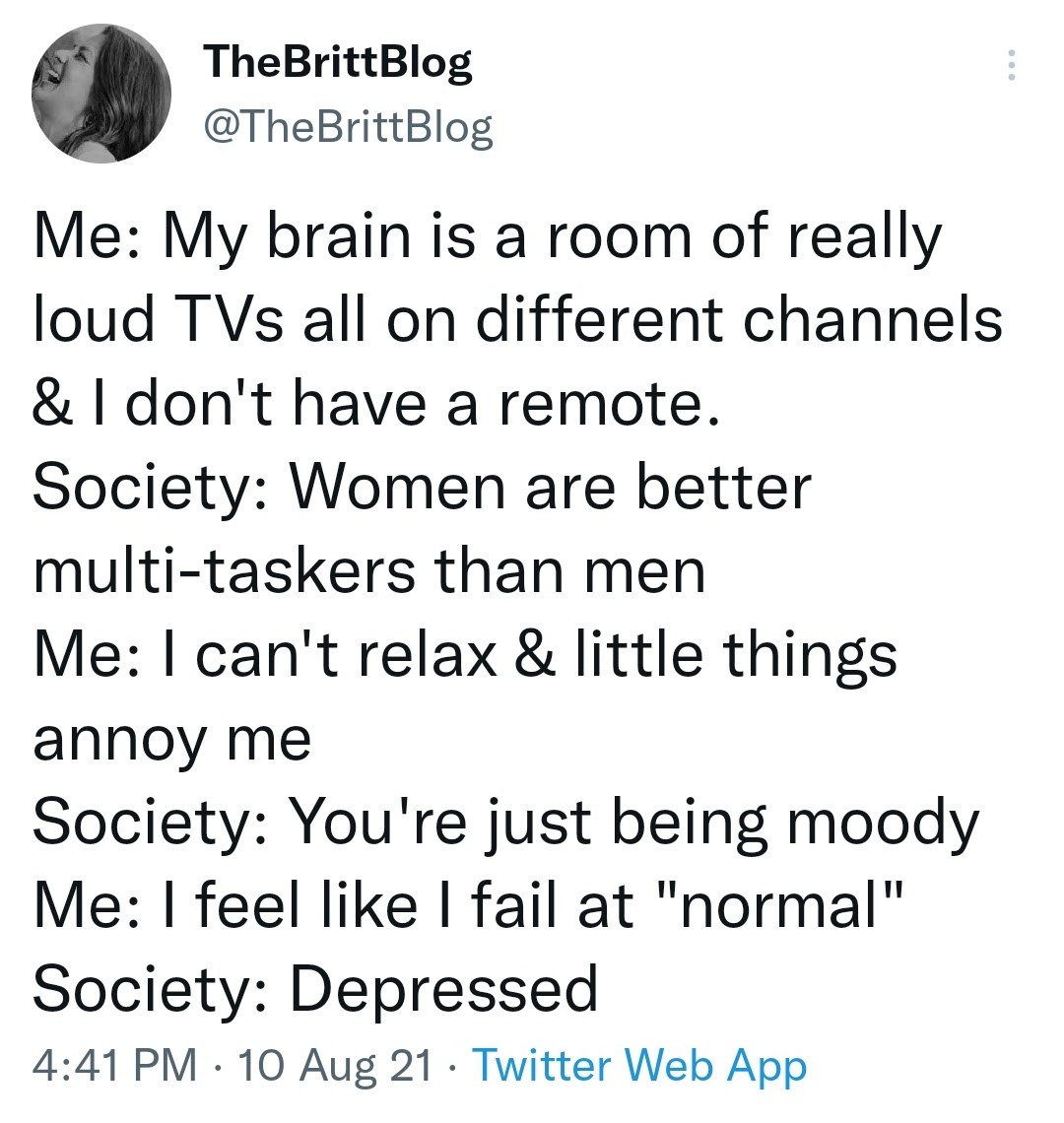I was formally diagnosed with ADHD a few months ago after years of suspecting something was up.
It unleashed a wave of complicated emotions – relief, validation, betrayal, sadness. For a while, I felt like I was in a state of mourning, wondering if or how my life would have been different had I had this information sooner.
Here is my story thus far, along with three things I wish more people knew about ADHD.
Brain like a room full of TVs
My presentation of ADHD skews more towards inattention than hyperactivity/impulsivity. I describe my brain as being a room full of TVs that are all on different channels and at different volumes and I can’t find the remote. I can recall countless times in elementary school when my mind would “zoom out” while in class, only to have it zoom back in and realize the teacher had just asked me a question and I had no clue what it was. But because I was a good student (I read at a 5th grade level when in 2nd grade), wasn’t super forgetful, and didn’t have random outbursts, no one thought anything about it. Also, what kid hasn’t daydreamed in class before?
But as I got older, this lack of focus became more overwhelming. And frustrating. I was the oldest of five siblings, a good student, a reliable friend. I had roles I was expected and needed to play, and I felt I’d be letting people down if they knew.
So, I masked my ADHD by being the funny-performer kid. I was the first to volunteer for everything. I got really involved in high school theater, sports, and extra-curricular activities that helped me channel my extra energy. But I screamed into my pillow at night because I was so angry at myself for not being “normal.” When my brain raced, I would hold the sides of my head as if to literally keep it in my skull. And I ultimately developed an eating disorder to try and take back control once and for all.
My diagnosis journey
In my early 20s, I made a first attempt at getting answers and filled out a free, 10-question online assessment (don’t waste your time on those, by the way). When I didn’t meet the criteria, I figured at least I had tried.
I got more and more into journaling, which was a gamechanger for helping me with racing thoughts and calming my brain. I also formed a consistent workout routine, and used planners and post-its to help me organize and remember tasks. But the symptoms continued.
Along the way, I had a lot of people invalidate or doubt my suspicions. I was told that everyone gets distracted from time to time, and that I should “just focus.” One doctor even declared that I was probably doing it for attention, as some kind of psychosomatic response to having a sibling already diagnosed with ADHD.
So when I started therapy this past June, I wanted to get answers once and for all. The first step was a written assessment where I answered 40 questions on how closely I identified to certain statements on a scale of 1 to 5 (1 being “I never experience this” and 5 being “I experience this all the time”). Based on those results, my therapist then recommended the Test of Variables of Attention (T.O.V.A.®). This test assesses inattention and impulsivity based on your response to visual and auditory stimuli. My results for the visual portion of the test were conclusive enough to confirm a diagnosis without the auditory portion.
Using the written assessment and T.O.V.A.® results, my therapist recommended cognitive behavioral therapy as a tool for helping me be more aware of my thought patterns and strengthen my emotional regulation skills.
What I wish more people knew about ADHD
It’s a real thing – and is more common than you think
Since being diagnosed, I’ve learned that an estimated 7% of children worldwide have ADHD, making it one of the most common neurodevelopmental childhood disorders.
ADHD typically gets diagnosed in childhood. So if you’re diagnosed as an adult, it means you’ve always had it. You may have gotten really good at masking it (like I did), but it didn’t come out of nowhere.

Women and girls are continue to be overlooked or misdiagnosed
Boys are three times more likely to be diagnosed than girls are. Research suggests that up to 75% of girls with attention problems are undiagnosed.
The reasons why are complex, but generally boil down to gender stereotypes and a continued misunderstanding of symptoms. Many women and girls will be diagnosed with mood disorders long before ADHD is even brought up. And while gender stereotypes fail everyone, women particularly bear the brunt of the fallout for failing to meet societal expectations.
So on top of not getting the support they need, many women and girls are made to feel immense guilt and shame for not being able to perform the roles expected of them. This YouTube video on ADHD in Women unpacks this in a great way.
Nothing is wrong with you
Before my diagnosis, one of my biggest fears was being out of control and people knowing that I didn’t really have my s**t together. It took so much energy to appear “normal” – to this day, I haven’t fully reconciled just how exhausting that was and the toll it took.
I know my experience is not unique. Chances are, some of you reading this either already have an ADHD diagnosis or are struggling to get one. I want you to know that your experience is valid and that you deserve to get the help and support you need.
This won’t be my last post about ADHD, but I do hope that sharing this part of my story can be helpful to those who need it. You are not alone, and nothing is wrong with you.



